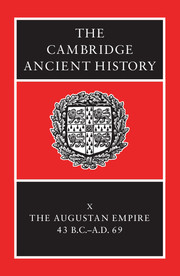13c - Spain
from 13 - The West
Published online by Cambridge University Press: 28 March 2008
Summary
CONQUEST, PROVINCIAL ADMINISTRATION AND MILITARY ORGANIZATION
The Iberian peninsula, the first overseas country in which Roman rule had been established (in 218 B.C.), became one of the most important areas of the empire at the beginning of the imperial period. This was due above all to the fact that the wars of conquest gave it an increasingly important military and political role. At the end of the Republic and during the triumviral period, when nearly two centuries of almost constant warfare had passed, and Roman civilization had struck root particularly along the eastern coast and in the south of the peninsula, north-western Spain, with its hardly accessible mountainous regions, still resisted Roman rule. From 39 B.C., there was a single proconsul with consular rank for both Hispanic provinces, Hispania Citerior and Hispania Ulterior (the ‘consular era’ of Hispania Citerior was later reckoned from 38 B.C.); he held the army command and was responsible for the civil administration under the mandate of Octavian/Augustus. Until the time of the last proconsul, Sextus Appuleius in 28/27 B.C., these governors were constantly occupied with war – in the Fasti Triumphales six triumphs are recorded for proconsuls of this period. But it was the first princeps who completed the task of subduing the rest of the peninsula, with the aim of seizing the chance to demonstrate his care for his provincia, to win laurels, and at the same time to be absent from Rome where his presence, after the provisional settlement of the new regime, might raise political problems.
Keywords
- Type
- Chapter
- Information
- The Cambridge Ancient History , pp. 449 - 463Publisher: Cambridge University PressPrint publication year: 1996



